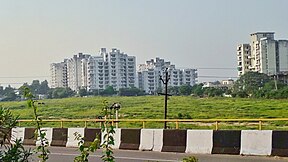Our website is made possible by displaying online advertisements to our visitors.
Please consider supporting us by disabling your ad blocker.
Moradabad
This article may require copy editing for grammar, style, cohesion, tone, or spelling. (April 2024) |
Moradabad | |
|---|---|
City | |
New Moradabad Skyline Pili Kothi Chowk Pilikothi Welcome Sign Sai Mandir Philips Memorial Methodist Church Jama Masjid Moradabad Railway Station Moradabad Entry Gate (Zero Point) | |
| Nickname: Brass City | |
 An old map of Moradabad (1955) | |
| Coordinates: 28°49′55″N 78°46′35″E / 28.83194°N 78.77639°E | |
| Country | India |
| State | Uttar Pradesh |
| District | Moradabad |
| Established | 1625[1] |
| Named for | Murad Bakhsh |
| Government | |
| • MP | Ruchi Veera (SP) |
| • Mayor | Vinod Agarwal (BJP) |
| • District Magistrate | Shri Manvendra Singh |
| • MLA | Ritesh Kumar Gupta (BJP) |
| Area | |
• Total | 79 km2 (31 sq mi) |
| Elevation | 198 m (650 ft) |
| Population (2011)[2] | |
• Total | 889,810 |
| • Density | 11,000/km2 (29,000/sq mi) |
| Demonym | Moradabadi |
| Languages | |
| • Official | Hindi, Urdu |
| Time zone | UTC+5:30 (IST) |
| PIN | 244001 |
| Telephone code | 0591 |
| Vehicle registration | UP-21 |
| Website | moradabad |
Moradabad (Hindi pronunciation: [mʊɾaːd̪aːbaːd̪] ⓘ) is an industrial city, commissionerate, and municipal corporation in Moradabad district of the Indian state of Uttar Pradesh. It is situated on the banks of the Ramganga river, at a distance of 192 km (119 mi) from the national capital, New Delhi and 356 km north-west of the state capital, Lucknow. Based on the 2011 census, it is 10th most populous city in the state[3] and 54th most populous city in the country.[4] It is one of the largest cities in the Western UP region, serving as a crucial hub for employment, education, industry, culture, and administration.
The city is popularly known as Pital Nagri ("Brass City") for its famous brass handicrafts,[5] which are exported across the world. In the last few decades it has started emerging as a hub for other metalworks also, which includes working with aluminium, steel, and iron.[6] In October 2014, leading financial daily Livemint included Moradabad in its list of "25 emerging cities to watch out for in 2025".[7]
Moradabad also holds the distinction of being among the 100 smart cities being modernized under the National Smart Cities Mission of the Union Government of India.[8]
Throughout its four centuries of existence, the city has gone through multiple regime changes. It was firstly a part of the Delhi Sultanate, then flourished under Mughal empire, then was annexed into the Kingdom of Rohilkhand in 1742, and then came under the control of Oudh State in 1774 after the fall of Rohillas in the First Rohilla War. Finally, it was ceded to the British East India Company by the Nawab of Oudh in 1801.[9] In the early 19th century, the British divided the Rohilkhand area into the Rampur State and two districts: the Bareilly and Moradabad districts. The city of Moradabad then became the headquarters of the latter.
Moradabad was connected with railway lines during the latter half of the nineteenth century. A line connecting Moradabad to Chandausi was built in 1872 and it was continued up to Bareilly in 1873. The Bareilly-Moradabad chord via Rampur was completed in 1894, which was extended to Saharanpur in 1886. A branch line to Aligarh via Chandausi was opened in 1894, while Moradabad was linked to Ghaziabad in 1900.[10][11] It is also the divisional headquarter of the Moradabad division of Northern Railway (NR).[12][13]
- ^ "About District - District Moradabad". moradabad.nic.in. Retrieved 12 October 2018.
- ^ "Provisional Population Totals, Census of India 2011; Cities having population 1 lakh and above" (PDF). Office of the Registrar General & Census Commissioner, India. Retrieved 26 March 2012.
- ^ "Indian Districts by Population, Sex Ratio, Literacy 2011 Census". www.census2011.co.in. Retrieved 27 March 2024.
- ^ "Cities having population 1 lakh and above, Census 2011" (PDF). Archived from the original (PDF) on 7 May 2012. Retrieved 27 March 2024.
- ^ Majid Husain (2011). Understanding: Geographical: Map Entries: for Civil Services Examinations: Second Edition. Tata McGraw-Hill Education. p. 7. ISBN 978-0-07-070288-2. Retrieved 6 October 2012.
- ^ "Official Website of One District One Product Uttar Pradesh / Moradabad". odopup.in. Retrieved 27 March 2024.
- ^ "Indias growth engines and gateways". Livemint.com. 30 October 2014. Retrieved 9 January 2015.
- ^ Jeelani, Mehboob (27 August 2015). "Centre unveils list of 98 smart cities; UP, TN strike it rich". The Hindu. Archived from the original on 26 November 2016. Retrieved 21 April 2017.
- ^ "Imperial Gazetteer of India, Volume 17, page 429 -- Digital South Asia Library". dsal.uchicago.edu. Retrieved 6 December 2019.
- ^ "Oudh and Rohilkhand Railway". Management Ebooks. Archived from the original on 11 January 2014. Retrieved 17 January 2014.
- ^ "IR History – Early Days II (1870-1899)". IRFCA. Retrieved 17 January 2014.
- ^ "Northern Railway: Moradabad Division". Moradabadrail.in. Archived from the original on 1 August 2015. Retrieved 29 July 2015.
- ^ "Moradabad (UP), India | Official Website". Moradabad.nic.in. Retrieved 29 July 2015.
Previous Page Next Page













